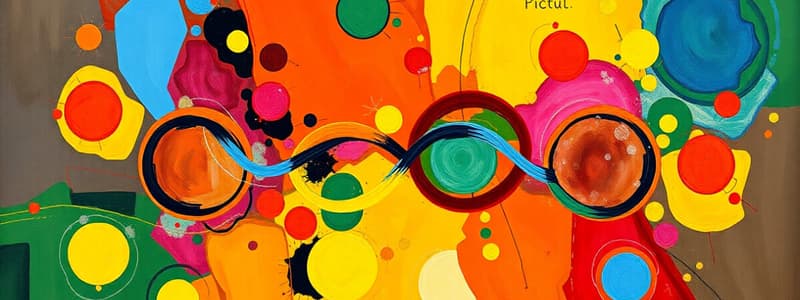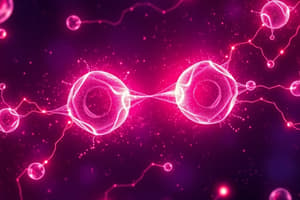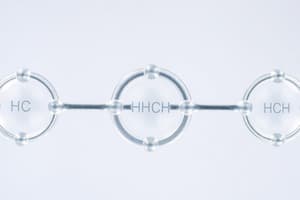Podcast
Questions and Answers
Sodium Chloride has a ______ structure.
Sodium Chloride has a ______ structure.
cubic
Each sodium ion is surrounded by ______ chloride ions.
Each sodium ion is surrounded by ______ chloride ions.
6
Metals tend to ______ electrons while non-metals tend to gain electrons.
Metals tend to ______ electrons while non-metals tend to gain electrons.
lose
An ionic compound must have the same number of positive and ______ charges.
An ionic compound must have the same number of positive and ______ charges.
The formula for Aluminium Oxide is ______.
The formula for Aluminium Oxide is ______.
A compound is a substance made up of two or more different elements combined together ______.
A compound is a substance made up of two or more different elements combined together ______.
The forces that hold the atoms together in a new substance are called ______ bonds.
The forces that hold the atoms together in a new substance are called ______ bonds.
According to the Octet Rule, atoms tend to reach an electron arrangement with ______ electrons in the outermost energy level.
According to the Octet Rule, atoms tend to reach an electron arrangement with ______ electrons in the outermost energy level.
Noble gases are considered ______ because they have stable electron configurations.
Noble gases are considered ______ because they have stable electron configurations.
An ion is a ______ atom or group of atoms.
An ion is a ______ atom or group of atoms.
A negative ion is called an ______.
A negative ion is called an ______.
An ionic bond is the force of attraction between ______ charged ions in a compound.
An ionic bond is the force of attraction between ______ charged ions in a compound.
The outer electrons of one atom in a dot and cross diagram are represented by ______.
The outer electrons of one atom in a dot and cross diagram are represented by ______.
A double bond consists of one sigma bond and one ______ bond.
A double bond consists of one sigma bond and one ______ bond.
The two 2px orbitals in a nitrogen molecule overlap head-on to form a ______ bond.
The two 2px orbitals in a nitrogen molecule overlap head-on to form a ______ bond.
Ionic compounds usually exhibit ______ melting and boiling points.
Ionic compounds usually exhibit ______ melting and boiling points.
The Valence Shell Electron Pair Repulsion Theory is also known as ______ Theory.
The Valence Shell Electron Pair Repulsion Theory is also known as ______ Theory.
Covalent compounds do not conduct electricity when ______ in water.
Covalent compounds do not conduct electricity when ______ in water.
Transition metals are found in the ______, except for Scandium and Zinc.
Transition metals are found in the ______, except for Scandium and Zinc.
A transition metal forms at least one ion with a partially filled ______ sub-level.
A transition metal forms at least one ion with a partially filled ______ sub-level.
Manganese can form ions with a charge of +2, +4, or +______.
Manganese can form ions with a charge of +2, +4, or +______.
Covalent bonding involves electrons being ______ between atoms.
Covalent bonding involves electrons being ______ between atoms.
A chlorine atom needs to create a stable octet by ______ electrons with another chlorine atom.
A chlorine atom needs to create a stable octet by ______ electrons with another chlorine atom.
The electrons not involved in bonding are called ______ pairs.
The electrons not involved in bonding are called ______ pairs.
A ______ bond is formed by the head-on overlap of two orbitals.
A ______ bond is formed by the head-on overlap of two orbitals.
Since oxygen combines with two atoms of hydrogen, it has a valency of ______.
Since oxygen combines with two atoms of hydrogen, it has a valency of ______.
The method for using the VSEPR Theory includes drawing a dot and cross diagram of the ______.
The method for using the VSEPR Theory includes drawing a dot and cross diagram of the ______.
In VSEPR Theory, the shape of a molecule is determined using the number of bond pairs and ______ pairs.
In VSEPR Theory, the shape of a molecule is determined using the number of bond pairs and ______ pairs.
A molecule with 3 bond pairs and 0 lone pairs is categorized as ______ planar.
A molecule with 3 bond pairs and 0 lone pairs is categorized as ______ planar.
Electronegativity is defined as the relative ______ that an atom in a molecule has for shared electrons.
Electronegativity is defined as the relative ______ that an atom in a molecule has for shared electrons.
In a polar covalent bond, there is ______ sharing of the pair of electrons.
In a polar covalent bond, there is ______ sharing of the pair of electrons.
The greater the electronegativity ______, the more polar the bond.
The greater the electronegativity ______, the more polar the bond.
A non-polar covalent bond involves atoms that share electrons ______.
A non-polar covalent bond involves atoms that share electrons ______.
The bond angle for a tetrahedral shape is ______ degrees.
The bond angle for a tetrahedral shape is ______ degrees.
Covalent bonding and polar covalent bonding are examples of ______ bonding.
Covalent bonding and polar covalent bonding are examples of ______ bonding.
Intermolecular forces are the forces of attraction that exist between ______.
Intermolecular forces are the forces of attraction that exist between ______.
Van der Waals forces are weak attractive forces between molecules resulting from the formation of temporary ______.
Van der Waals forces are weak attractive forces between molecules resulting from the formation of temporary ______.
Van der Waals forces are the only forces of attraction between ______ molecules.
Van der Waals forces are the only forces of attraction between ______ molecules.
Dipole-Dipole forces occur between the negative pole of one polar molecule and the positive pole of another ______ molecule.
Dipole-Dipole forces occur between the negative pole of one polar molecule and the positive pole of another ______ molecule.
Hydrogen Bonds are particular types of dipole-dipole attractions between molecules in which Hydrogen atoms are bonded to ______, Oxygen or Fluorine.
Hydrogen Bonds are particular types of dipole-dipole attractions between molecules in which Hydrogen atoms are bonded to ______, Oxygen or Fluorine.
The strength of Van der Waals forces increases with the size of the ______.
The strength of Van der Waals forces increases with the size of the ______.
The hydrogen bond acts as a bridge between two electronegative atoms in ______ molecules.
The hydrogen bond acts as a bridge between two electronegative atoms in ______ molecules.
Flashcards
Ionic Compound Formula
Ionic Compound Formula
A way to represent a compound using element symbols and numbers to show how many atoms of each element are present.
Crystal Lattice
Crystal Lattice
The three-dimensional arrangement of ions in an ionic compound.
Ionic Compound Formation
Ionic Compound Formation
Ionic compounds are usually formed between metals (groups I & II) and non-metals (groups VI & VII).
Neutral Ionic Compound
Neutral Ionic Compound
Signup and view all the flashcards
Determining Ionic Formula (Example)
Determining Ionic Formula (Example)
Signup and view all the flashcards
Compound
Compound
Signup and view all the flashcards
Chemical Bond
Chemical Bond
Signup and view all the flashcards
Octet Rule
Octet Rule
Signup and view all the flashcards
Ionic Bond
Ionic Bond
Signup and view all the flashcards
Ion
Ion
Signup and view all the flashcards
Cation
Cation
Signup and view all the flashcards
Anion
Anion
Signup and view all the flashcards
Dot and Cross Diagram
Dot and Cross Diagram
Signup and view all the flashcards
Double Bond
Double Bond
Signup and view all the flashcards
Triple Bond
Triple Bond
Signup and view all the flashcards
Sigma Bond
Sigma Bond
Signup and view all the flashcards
Pi Bond
Pi Bond
Signup and view all the flashcards
VSEPR Theory
VSEPR Theory
Signup and view all the flashcards
Transition Metal
Transition Metal
Signup and view all the flashcards
Transition Metal Ion Charge
Transition Metal Ion Charge
Signup and view all the flashcards
Covalent Bond
Covalent Bond
Signup and view all the flashcards
Molecule
Molecule
Signup and view all the flashcards
Valency
Valency
Signup and view all the flashcards
Iron(II) Carbonate Formula
Iron(II) Carbonate Formula
Signup and view all the flashcards
Linear Shape
Linear Shape
Signup and view all the flashcards
V-Shaped
V-Shaped
Signup and view all the flashcards
Triangular Planar
Triangular Planar
Signup and view all the flashcards
Pyramidal
Pyramidal
Signup and view all the flashcards
Tetrahedral
Tetrahedral
Signup and view all the flashcards
Electronegativity
Electronegativity
Signup and view all the flashcards
Polar Covalent Bond
Polar Covalent Bond
Signup and view all the flashcards
Intermolecular Forces
Intermolecular Forces
Signup and view all the flashcards
Van Der Waals Forces
Van Der Waals Forces
Signup and view all the flashcards
Dipole-Dipole Forces
Dipole-Dipole Forces
Signup and view all the flashcards
Hydrogen Bonding
Hydrogen Bonding
Signup and view all the flashcards
What makes Van Der Waals forces stronger?
What makes Van Der Waals forces stronger?
Signup and view all the flashcards
How do intermolecular forces affect physical properties?
How do intermolecular forces affect physical properties?
Signup and view all the flashcards
What are the strongest type of intermolecular forces?
What are the strongest type of intermolecular forces?
Signup and view all the flashcards
How are Van Der Waals forces different?
How are Van Der Waals forces different?
Signup and view all the flashcards
Study Notes
Chemical Bonding
- A compound is a substance made of two or more different elements combined chemically.
- Attractive forces, called chemical bonds, hold the atoms together in a compound.
- The Octet Rule describes how atoms tend to gain, lose, or share electrons to achieve an electron arrangement with eight electrons in their outermost energy level.
- Noble gases have stable electron configurations with eight or two electrons in their outermost level, so they do not react.
- Transition metals often do not follow the octet rule
- Hydrogen, lithium, and beryllium often achieve a full outer shell with just two electrons.
- An ion is a charged atom or group of atoms that has gained or lost electrons.
- Ionic bonding occurs when electrons are transferred completely from one atom to another, forming ions that attract each other.
- A cation is a positively charged ion.
- An anion is a negatively charged ion.
- An ionic bond is the force of attraction between oppositely charged ions.
Ionic Compounds: Formulas
- Chemical formulas represent compounds using element symbols and numbers to show how many atoms of each element are present.
- Ionic compounds are usually formed from metal groups I and II combining with non-metal groups VI and VII.
- Ionic compounds are neutral, so the positive and negative charges in the compound must be equal.
- Common Polyatomic ions (include their charges and formulas)
- Hydroxide (OH⁻)
- Nitrate (NO₃⁻)
- Hydrogencarbonate (HCO₃⁻)
- Permanganate (MnO₄⁻)
- Carbonate (CO₃²⁻)
- Chromate (CrO₄²⁻)
- Dichromate (Cr₂O₇²⁻)
- Sulfate (SO₄²⁻)
- Sulfite (SO₃²⁻)
- Thiosulfate (S₂O₃²⁻)
- Phosphate (PO₄³⁻)
- Ammonium (NH₄⁺)
Writing Ionic Compound Formulas
- Determine the charges of the ions involved.
- Find the lowest common multiple of the absolute values of the charges.
- Use the lowest common multiple to determine the number of each ion needed to balance the charges.
- Write the formula using the subscripts to indicate the number of each ion.
Covalent Bonding
- Covalent bonding involves the sharing of electrons between atoms.
- A molecule is a group of atoms joined together, the smallest particle of an element or compound that can exist independently.
- Single, double, or triple bonds represent the number of electron pairs shared between atoms.
- A single bond = one shared pair
- A double bond = two shared pairs
- A triple bond = three shared pairs
- Chlorine gas (Cl2) shares a pair of electrons, a single covalent bond, so Cl2 is a molecule.
- Oxygen needs two pairs of electrons (two covalent bonds) to reach a full outer shell of 8 electrons, forming a molecule (O2).
- Hydrogen gains a pair, and hydrogen atoms gain a full outer shell of 2 electrons so H2 is a molecule
Shapes of Covalent Molecules
- Use VSEPR (valence shell electron pair repulsion) theory to predict the shape of a molecule. Count the bond pairs and lone pairs around the central atom.
Electronegativity
- Electronegativity is the tendency of an atom to attract shared electrons in a covalent bond
- A large electronegativity difference indicates polar covalent bonds (unequal sharing).
- A small difference indicates nonpolar covalent bonds (equal sharing)
- Polar bonds result in a slightly positive end (δ+) and a slightly negative end (δ-)
Types of Covalent Bonds
- nonpolar covalent: bonds with equal sharing of electrons
- polar covalent: bonds with unequal sharing of electrons resulting from a difference in electronegativity between the atoms
Intermolecular Forces
- Intramolecular bonds occur within a molecule.
- Intermolecular forces occur between molecules. Examples include Van der Waals forces, dipole-dipole forces, and hydrogen bonding
- Van der Waals forces: weak attractive forces between non-polar molecules due to temporary dipoles
- Dipole-dipole forces: attractive forces between the positive end of one polar molecule and the negative end of another polar molecule.
- Hydrogen bonding: a strong type of dipole-dipole force that occurs when hydrogen is bonded to a highly electronegative atom.
- These interactions greatly affect boiling/melting point. Larger molecules generally (but not always) have higher boiling points due to stronger intermolecular forces.
Studying That Suits You
Use AI to generate personalized quizzes and flashcards to suit your learning preferences.




